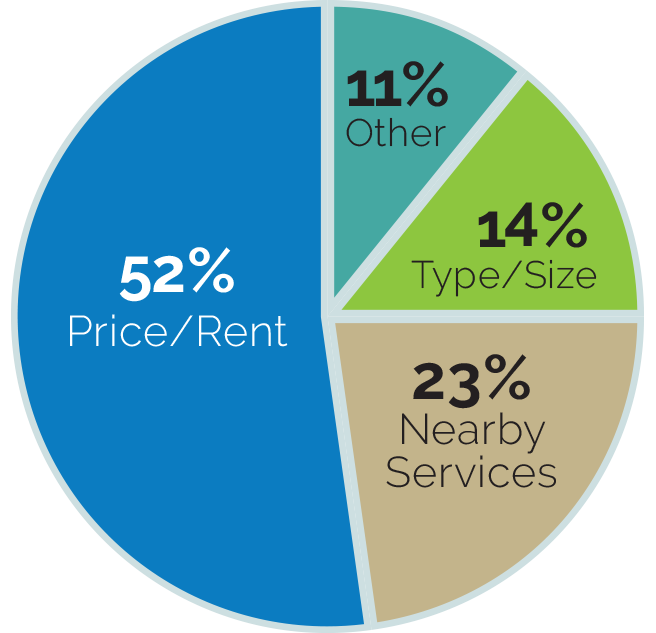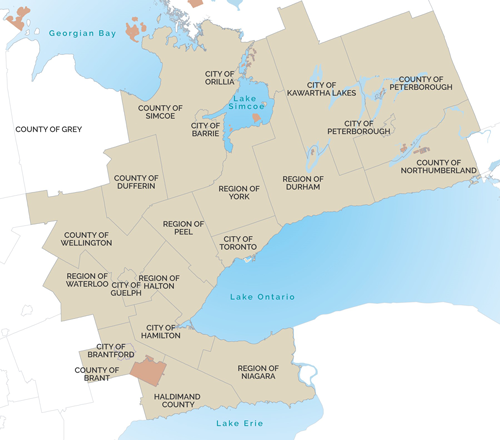Note: More Homes, More Choice Act received Royal Assent on June 6, 2019.
Minister’s message

Steve Clark
Minister of Municipal Affairs and Housing
Every town, city and community in Ontario is unique. But no matter where you go, one thing is the same – people are looking for housing that meets their needs and their budget.
Young families are searching for their first home, close to schools, where they can build a life and raise children. Seniors are thinking about downsizing and want homes that meet their needs as they age, staying in neighbourhoods they love. College and university students need a place to live close to school while they study. So many people want to live where they can commute to their jobs easily, and get home to family and friends faster, so that they can enjoy their down-time.
Everyone is looking for something different, and each person has a budget. The cost of buying a home is becoming out of reach for many and affordable rentals are too hard to find. Plus, the cost of housing is hurting Ontario’s economy, making it harder to attract investment and create jobs.
Ontario needs more housing, and we need it now. It’s time for our government to take action.
We must build smart and we must be flexible. Housing must be built in the right places, so we can maintain Ontario’s vibrant agricultural sector and employment lands, protect sensitive areas like the Greenbelt and preserve cultural heritage. Every community should build in response to local interests and demand, building a mix of housing to accommodate diverse needs.
Government cannot address the housing crisis on its own. We can make it easier for municipalities, non-profits and private firms to build housing. We can help to boost supply and give people more choice.
More homes, more choice outlines our government’s plan to tackle Ontario’s housing crisis and encourages our partners to do their part by starting now, to build more housing that meets the needs of people in every part of Ontario.
Ontario’s housing crisis
This infographic details the realities of Ontario’s housing crisis. But how did we get here? To start, building housing takes too long and costs too much. There is red tape, unexpected changes and government fees that add years of paperwork and can also contribute tens of thousands of dollars to the cost of an average home. These layers of regulation and “not-in-my-backyard” attitudes make it hard to build different kinds of homes – the townhomes, mid-rises and family-sized apartments that the people need. Meanwhile, rents skyrocket because it is difficult and costly to build new rentals and to be a landlord.
The province doesn’t build housing, but we can cut red tape to create conditions that make it easier to build housing and introduce policies that encourage densification. We can also make the most of infrastructure investments and encourage more density around major transit stations. We can do all these things while maintaining important protections for existing residents of stable communities, a vibrant agricultural sector, employment lands, the Greenbelt, our cultural heritage and the environment.
Chart 1: Ontario’s housing crisis

Source: based on data from Statistics Canada, Canadian Real Estate Association, PadMapper, Canada Mortgage and Housing Corporation, RESCON: Streamlining the Development and Building Approvals Process in Ontario, July 2018 and BILD: Build for Growth in Toronto.
- Estimates based on Statistics Canada (household incomes), Bank of Canada (mortgage rate), Canada Mortgage and Housing Corporation (apartment rents and mortgage insurance rate) and Canadian Real Estate Association (resale home prices).
- Ontario and the Greater Toronto Area on average 2014-18.
- Asking (median) rents for two-bedroom apartments as of February 2019.
- After-tax (median) household incomes 2008-17.
- Canada Mortgage and Housing Corporation 2018 Rental Market Survey
Vision
All Ontarians can find a home that meets their needs and their budget.
Our plan will:
Cut red tape to make it easier to build the right types of housing in the right places
Make housing more affordable
Help taxpayers keep more of their hard-earned dollars
Housing for all Ontarians
Housing innovation isn’t just about new designs and materials, it’s about creative partnerships too. By working together, non-profits, co-ops and the private sector can help solve Ontario’s housing crisis.
When individuals find a home, they are healthier and more productive. This benefits not only the individual, but also the province, as each person has the opportunity to contribute to our economy.
More housing that meets people’s needs and budgets boosts Ontario’s economy by helping us keep jobs and support job creation. Businesses – from manufacturers to high tech firms – need employees, and those employees need affordable places to live. By making housing more affordable, businesses large and small will invest in Ontario again.
More homes, more choice is about unlocking the development of all kinds of housing. From ownership to rental housing, whether built by private developers or non-profits, our action plan will help give people more choice and help bring costs down.
This plan is complemented by our Community Housing Renewal Strategy, which helps people with low and moderate incomes who can’t afford today’s high rents to find affordable housing. It will transform a fragmented and inefficient system into one that is more streamlined, sustainable and ready to help people who need it most. It also includes early steps to improve community housing across the province:
- helping tenants become economically self-sufficient
- making it easier to predict and calculate rent
- shortening waiting lists
- helping people in greatest need
- making community housing safer
We will work with municipalities and non-profits to sustain, repair and grow our community housing system.
Together, these plans respond to the diverse housing needs of all Ontarians.
What we heard

Chart 2: Ontarians’ priorities when looking for a home
Source: Ontario housing supply consultation, 2019
We asked the people of Ontario to share their ideas on how to build more housing and make housing more affordable. We received more than 2,000 submissions.
Over 85% of the submissions came from the public and more than half said affordability was their top criteria when looking for a home, followed by having transit, schools and services nearby.
As well as the online consultation, we held dozens of meetings with stakeholders from across the province and hosted a forum with more than 200 experts to discuss innovation.
While we heard loud and clear that finding a home is important, Ontarians said that we must protect our environmentally sensitive areas, including the Greenbelt, cultural heritage assets and key employment and agricultural lands.
We heard that the government should focus development in areas with existing services, transit and infrastructure.
We heard that housing rules need to be easier to understand, for example when homeowners want to build and rent out a basement apartment. As we act to help build more rentals, we heard that protecting tenants from unlawful evictions and making sure buildings are well maintained were top priorities.
More homes, more choice proposes a range of solutions – early steps and longer-term approaches – to address Ontario’s housing crisis. There is no quick fix for such a complex and wide-ranging issue as housing and our plan lays the foundation for the future.
We are not touching the Greenbelt. We will protect it and all its beauty.
Premier Ford (Twitter, December 7, 2018)
Housing supply: Ontario’s five-point plan
Speed:
Red tape and paperwork can add years to a construction project. We will maintain Ontario’s strong environmental protections, while making the development approvals process faster.
Cost:
Layers of permits, government approvals and charges by municipalities add to the cost of building new homes. We will make costs more predictable, to encourage developers to build more housing.
Mix:
We’ll make it easier to build different types of housing – from detached houses and townhomes to mid-rise rental apartments, second units and family-sized condos. We need a variety.
Rent:
There are more people looking for homes than there are places to rent. We will protect tenants and make it easier to build rental housing.
Innovation:
This means everything from new housing designs and materials to creative approaches to home-ownership and more. We’ll encourage more innovation and creativity in Ontario’s housing sector and make sure government isn’t standing in the way.
What we have already done
We inherited Ontario’s housing crisis, and we are taking action to fix it.
Skilled workforce to build Ontario’s homes
Land to build Ontario’s homes

We will sell the hundreds of unused properties across the province that the government owns, and wastes millions of taxpayer dollars every year to maintain, to build more homes, long-term care facilities and affordable housing.
In the last six months we’ve freed up land to build new housing in communities across Ontario – from London to Quinte to Hornepayne.
More choice for renters
Rent control made finding a rental unit harder for renters and discouraged landlords and developers from creating more apartments. We’ve exempted new rental units from rent control to encourage new rental construction so that there can be more choice for tenants. An increase in supply should help bring rents down.
Cost-effective building
Wood is a renewable resource as well as an innovative, cost-effective and modern building material that supports 150,000 jobs in Ontario’s forestry sector. In our Made-in-Ontario Environment Plan we committed to increase the use of timber in the home building industry, and this includes training architects, engineers and skilled trades to work with wood and encouraging mass timber demonstration projects.
Investing in infrastructure
Our action plan to boost the supply of housing means Ontario will need more infrastructure, in good repair. Our ten-year, $30 billion bilateral infrastructure program will improve Ontario’s roads and bridges, increase the capacity of our transit systems and improve community, cultural and recreational facilities across the province.
Improving transportation networks
The province has also invested in transit across the province – including improved service for transit users and commuters as well as the reveal of our government’s transit vision. We’re also making it easier to transform commuter parking lots at transit stations into places with homes and businesses. We have already revealed plans for transit-oriented development at Mimico and Woodbine, and this is just the start.
Greater Golden Horseshoe
The Greater Golden Horseshoe is the economic engine of our province, generating more than 25% of Canada’s Gross Domestic Product. Right now, approximately 9.2 million people, or 25% of Canada’s population, live in this area and that number keeps growing – fast.

To make sure that our policies put people first, we are updating A Place to Grow: Growth Plan for the Greater Golden Horseshoe. It is the product of a broad consultation where we heard from more than 1,100 people and received more than 650 submissions. We heard the government should facilitate the building of affordable housing options near transit to prevent sprawl and protect agricultural lands. The plan will help manage growth so communities in the region develop in ways that expand economic opportunity, while maintaining protections for our environmentally sensitive areas, including the Greenbelt, cultural heritage assets, and key employment and agricultural lands.
We need to build more housing that people can afford so people have places to live near stable, reliable employment. That’s why we’re creating provincially significant employment zones to make sure that businesses – from manufacturers and industrial parks to high-tech offices – have room to grow.
What we are doing
It can take years of paperwork before a shovel ever breaks ground on a new housing project. Some government policies and processes are duplicated and can create delays for no reason, which drives up costs for home buyers.
That’s why we’re reviewing every step of the development process and every policy, regulation and piece of legislation to eliminate unnecessary steps, duplication and barriers. We are cutting red tape and as we do, we are holding firm to our commitment to ensure the health and safety of Ontarians, and protect the environment, agricultural lands and our rich natural heritage.
Making it easier to build new housing

We are making it easier and faster to build more housing near transit. For example, areas around bus and light rail stations could see 2,100 to 5,500 new homes.
Land use planning helps municipalities manage land and resources and guides decisions about where to build homes and factories, where to put parks and schools, and where roads, sewers and other essential services are needed. We’re proposing changes to the Planning Act to:
- bring housing to market faster by speeding up local planning decisions and making the appeals process more efficient
footnote 2 - make it easier for homeowners to create residential units above garages, in basements and in laneways
footnote 3 - help build housing, including affordable housing, near transit
footnote 4 - help municipalities implement community planning permit systems (e.g. in major transit station areas and provincially significant employment zones), which will streamline planning approvals to 45 days
footnote 5 - simplify how funds are collected for community benefits such as parks and daycares
footnote 6 - make upfront development costs easier to predict
footnote 7 - give communities and developers more certainty on what they can build, and where they can build it
footnote 8
Conflicts can arise during the process of land use planning. The Local Planning Appeal Tribunal hears these disputes, but there is a backlog of Ontario Municipal Board legacy cases -- approximately 100,000 units are tied up in Toronto alone. There are also too many complex processes standing in the way of creating new housing. We’re proposing changes to:
- hire more adjudicators to help address the backlog of legacy cases by investing $1.4 million in 2019-20
- ensure the tribunal has the powers and resources needed to make more timely decisions
- allow the tribunal to make the best planning decisions in the place of Council
footnote 9 - charge different fees and move towards a cost recovery model, while allowing community groups and residents to maintain affordable access to the appeals process
As more housing is built, we want to create strong, healthy communities. That means balancing environmental, economic and social factors, protecting health and safety, and managing resources wisely. We’re considering changes to the Provincial Policy Statement to:
- encourage the development of more and different types of housing
- reduce barriers and costs for developers and provide greater predictability
- update planning and development policies to reflect Ontario’s changing needs
- recognize local decision-making in support of new housing and economic development
Development charges help pay for infrastructure such as roads, transit, water/sewers and fire and police facilities. We believe that growth must pay for growth and it’s important that municipalities have the resources to support complete communities. Municipalities collect development charges following processes set out in the Development Charges Act. We’re proposing changes to:
- reduce the costs to build priority housing types, like second units
footnote 10 - fully cover municipalities’ waste diversion costs
footnote 11 - make the costs of development clear from the outset. This will protect new home buyers, as development charges are often passed directly on to the consumer
footnote 12

A non-profit housing project in Hamilton requested a minor change and waited almost two years for approvals. In that time, construction and material costs increased by 20-25%. Our plan would help reduce official plan approvals timelines by three months, subdivision plans by two months, and zoning by-law changes by two months to cut red tape and help build housing faster.
Ontario’s Building Code sets standards for safe, healthy and accessible buildings. We’re proposing to:
- remove the requirement that all new homes include the infrastructure for an electric vehicle charging station – whether the purchaser owns an electric vehicle or not – reducing unnecessary costs
- harmonize our Code with National Codes to open new markets for manufacturers and bring building costs down
When a board has more students than it has school space to accommodate them, it can levy education development charges on new development. These fees are used to acquire sites to help accommodate children from new developments, so they can learn close to home. After consulting with stakeholders, we’re proposing changes to the Education Development Charge framework to:
- allow only modest increases in education development charges to help make housing more affordable
- allow for innovative and lower-cost alternatives to site acquisition
We all want Ontario’s workplaces to be safe and healthy, including construction companies. We’re proposing changes to the Occupational Health and Safety Act to:
- reduce employers’ training costs and unnecessary paperwork
- make it easier to certify employer Joint Health and Safety Committee representatives
Reducing Workplace Safety and Insurance Board premiums for construction company employees who don’t work in the field will help reduce construction costs – especially for smaller firms.
Protecting what matters
Ontario’s natural and historic resources are protected in legislation – in some cases, different and overlapping laws, enforced by multiple agencies. We will maintain important protections, while reducing duplication and making it easier for people to understand what the law means.
Ontario values and protects its heritage properties while working with property owners and communities to manage change and compatible development. We’re proposing changes to the Ontario Heritage Act to:
- maintain local control over heritage conservation decisions, while providing clear direction and timelines for local decision-makers, heritage professionals and development proponents about protecting heritage properties
footnote 13 - create a consistent appeals process
footnote 14
Before they start a project, the province, municipalities, private firms and public bodies must consider the effects on the environment. These complex, administrative steps can slow down projects – like transit, flood protection or roads – that affect housing development, even if they pose little risk to the environment. We will streamline processes and identify efficiencies while protecting the environment and human health. We’re proposing changes to the Environmental Assessment Act, the Environmental Protection Act and regulations to:
- address duplication and streamline processes for projects that pose little risk to the environment
- provide clarity to proponents from the outset by better recognizing other planning processes
- reduce the amount of soil sent to landfill from construction sites, by making it easier and safer to reuse soil and penalizing those who illegally dump excess soil
- clarify the rules and remove unnecessary barriers to building on vacant land, to put prime land back to good use while protecting the environment and human health
- improve service standards to reduce delays
Conservation authorities protect people, property and natural resources from the threats and impacts of extreme weather and flooding. We’re proposing changes to the Conservation Authorities Act to:
- clearly define conservation authorities’ core programs and services, such as flood protection, and only require municipalities to pay for these services, not frivolous additional expenses
- give municipalities more say over non-core programs and services and how municipalities pay for them
- streamline and standardize conservation authorities’ role in municipal planning to reduce overlap, making approvals faster and less expensive
- improve governance and accountability
We can improve the effectiveness of our environmental protections and ensure a balanced approach between a healthy environment and a healthy economy. Under the guiding principles of clear rules paired with strong enforcement, streamlining and eliminating duplication and making transparency a priority, we’re proposing changes to the Endangered Species Act to:
- make it easier to harmonize the Endangered Species Act with other equivalent legislation
- establish Canada’s first Species at Risk Conservation Trust so project proponents can support strategic, coordinated and large scale actions instead of completing piecemeal requirements for permits, agreements and regulatory exemptions
- offer more certainty by improving processes
- provide clarity on how protected species are identified and transparent rules on how to protect habitat
- support a modern ecosystem-wide approach to species protection, one that balances competing interests, that is effective and efficient
To bolster our commitment to make Ontario open for business, open for jobs, our government will consult on the provincial natural heritage system policies to improve current access to mineral aggregate resources strictly within the Growth Plan area. Our goal is to foster an environment for growth while maintaining our commitment to conservation by cutting red tape and reducing regulations that currently stand in the way.
What we’re doing for renters
In today’s market, finding an affordable rental apartment can feel like winning the lottery. People are renting longer and more people are looking for a place to rent, but new construction has focused on condominiums rather than rental apartments.
Many of the changes in More homes, more choice will make it easier to build rental housing. For example, right now, home builders pay development charges up-front. A developer who builds a house and/or condominium builders can offset these development charges by preselling units. A developer who builds a rental unit can’t. By postponing development charges until the buildings are rented, developers will be encouraged to start building rental housing again. More homes, more choice will also work to cut red tape around development approvals so new homes will be available to rent sooner.
Making it easier for landlords to navigate the complex building code approvals process will help create more rental housing. In Ontario, roughly 30,000 to 35,000 new homes are built each year, and many of them could include secondary suites, like basement apartments.
We’re encouraging small landlords to create new rental units too, by making it easier to build second suites (like basement apartments) and helping them navigate the complicated building code approvals process. We are also expanding development charge exemptions to include second units in new homes.
As more rental units are built, tenants will have more choices and rents will decrease.
Creating more rental units is an essential part of our action plan. But once they have a place to live, renters shouldn’t have to worry about being treated unfairly or being unlawfully evicted. Ontario has strong protections for renters and we will do more to help tenants and landlords know their rights and how to resolve disputes.
Helping renters and landlords resolve disputes is the role of the Landlord and Tenant Board, but a shortage of adjudicators has created delays – average wait times are more than two months! The government is working with Tribunals Ontario on addressing shortages of adjudicators at the Landlord and Tenant Board. There have been a number of recent appointments and recruitment is underway to fill other adjudicator vacancies.
Our government is also providing more than one billion dollars in 2019-20 to help sustain, repair and grow community housing and help end homelessness. Hundreds of organizations across Ontario have long-standing agreements to provide community housing to Ontario’s most vulnerable, and as many of these agreements approach their end, our government’s Community Housing Renewal Strategy will help them become more sustainable.
What we will do
What are the rules for creating a basement apartment or converting another space in the house to rent it out? We will give homeowners a user-friendly checklist to help them build legal second units.
While we’ve started comprehensive legislative changes, there is more work to do to make it easier to build homes across the province.
Different parts of Ontario need different solutions. In the North, construction is more expensive and the season is short, but the planning approvals process doesn’t take that into account. Some municipalities – especially in Northern and rural Ontario – have faced excessive red tape and administrative burdens that make no sense in the local context or market. That needs to change.
Whether you’re building a few homes a year, or hundreds of homes every month, large parts of the planning process are the same. To remove red tape and make sure the approval process fits the project, we are working with municipalities and developers to understand what works, and what doesn’t. These specific changes save local communities time and money.
We also need more data about Ontario’s housing system so everyone can understand what is working and what isn’t. We’ll work with our municipal and federal partners to gather the information needed to drive informed decisions and make a difference for the people.
Employers need housing solutions too. Particularly seasonal industries like tourism and agriculture, or in rural areas where housing is in short supply. Companies struggle to fill these jobs because employees have no place to live. We’ll work with municipalities and businesses to find housing solutions that help communities across Ontario attract investment and good jobs.
To solve new problems, you need new ideas. By working together, the private, public and non-profit sectors can achieve far more than they can on their own.
Innovative designs, construction techniques and materials can bring costs down and give consumers more choices, including making homes more accessible as we age and for people with disabilities. Our upcoming Forest Sector Strategy will help Ontario’s forest industry innovate and build homes with advanced technologies, such as engineered wood products and prefabrication – housing that is manufactured off-site, in sections that can simply be shipped and assembled.
Fresh approaches to housing and home-ownership also give people more choices – like a “life lease” that allows a senior to age in place, without having to own their home. Or if seniors who want to co-own a house instead of living alone or moving into a retirement home. We’re developing guides to make it easier for people who want to live differently.
By clarifying rules and helping people understand how to take advantage of creative solutions, we will make it easier to innovate. We will continue to review our legislation and regulations to make sure they spur – not restrict – flexibility, creativity and new solutions.
Consumer protection

Buying a home is the biggest investment most people make and the lack of housing supply has made the dream of home ownership out of reach for many Ontarians.
We’re looking at all stages of the new home building and buying process, to protect consumers:
- Before they buy a home: making it easier for new home buyers to check out a developer’s track record in the Ontario Builder Directory
- During construction: adding more proactive, risk-based inspections by Tarion during construction to make sure homes are built properly
- After they move in: when new home buyers have problems, creating an easy-to-use process to help them resolve disputes quickly and fairly
We’re transforming the broken Tarion Warranty Corporation – which protects new home buyers against shoddy construction and delays – so home builders aren’t regulating themselves. We’re strengthening protections for new home buyers and helping people who have bought condominiums, only to have the project cancelled.
Conclusion
We inherited a confusing and broken housing development system that’s impossible for people and home builders to navigate and this has led to a housing shortage and skyrocketing housing prices and rents.
The people of Ontario deserve better.
We cannot fix the housing shortage on our own, but we can cut red tape to make it easier to build new housing for people to rent or own. We will give the people of Ontario more choice and make housing more affordable.
More homes, more choice outlines how we will cut red tape and reduce regulation, so it is easier to build homes – including, different types of homes – so that the people of Ontario can find something that suits their needs. Our plan will spur innovation while protecting tenants, health and safety, our cultural heritage and the environment. This plan encourages developers, municipalities and communities to work together to ensure the hard-working people of Ontario will have homes that meet their needs and their budgets.
Chart descriptions
Chart 1: Ontario’s housing crisis
Home prices and rents in many large and mid-sized cities have risen faster than incomes.
- 83% of buyers can’t afford average resale home
- Resale home prices up 8 to 9%
- Rental prices up 10 to 15%
- 56% of renters can’t afford average 2-bedroom apartment
- Less than 2% of rentals are vacant while incomes are only up 2% per year
Lengthy approvals and high costs have slowed down the building of new housing and rentals.
- Less than 7% of new housing built in the past 20 years was intended for rentals
- 10 years to build apartments in the GTA
- It takes 2+ years for site plan approvals for new buildings and major renovations
Chart 2: Ontarians’ priorities when looking for a home
This chart shows that 52% of Ontarians prioritize price or rent, 23% nearby services, 14% type or size of home, and 11% other factors.
Footnotes
-
footnote[1]
Back to paragraph
In fall 2018, the government introduced the Making Ontario Open for Business Act, 2018, which reduced journeyperson‐to‐apprenticeship ratios where they apply, placed a moratorium on trade classifications and reclassifications, and enabled the wind‐down of the Ontario College of Trades. The government’s vision for a modernized, client‐focused apprenticeship and skilled trades system will be implemented through the following initiatives:
- Establishing a new governance framework through proposed new legislation to replace the Ontario College of Trades and Apprenticeship Act, 2009;
- Encouraging employer participation in the apprenticeship system through a new financial incentive program to support employers to come together and train apprentices;
- Modernizing service delivery in apprenticeship by developing a new client‐facing digital system, including a one‐window digital portal for apprentices; and
- Promoting apprenticeship and the skilled trades as a pathway choice for all students from kindergarten to Grade 12.
- footnote[2] Back to paragraph The proposed planning decision timelines are 120 days for official plans, generally 90 days for zoning by-laws and 120 days for plans of subdivision. The Local Planning Appeal Tribunal’s authority is also proposed to be broadened to allow the Tribunal to make decisions based on the best planning outcome for appeals of major planning matters. This Planning Act change would be supported by changes that are being proposed to the Local Planning Appeal Tribunal Act.
- footnote[3] Back to paragraph Changes are proposed that would require municipalities to authorize additional residential units for detached, semi-detached and row houses in both the primary dwelling and ancillary building or structure.
- footnote[4] Back to paragraph Changes are proposed that would focus the discretionary use of inclusionary zoning to areas that are generally high-growth and are near higher order transit. This includes protected major transit station areas and areas where a community planning permit system has been required by the Minister of Municipal Affairs and Housing.
- footnote[5] Back to paragraph Changes are proposed that would enable the Minister to require the use of the community planning permit system in specified areas, such as major transit station areas and provincially significant employment zones, and remove appeals associated with its implementing planning documents.
- footnote[6] Back to paragraph A new authority is proposed to be created under the Planning Act that would allow municipalities to charge for community benefits, like libraries and daycare facilities.
- footnote[7] Back to paragraph The proposed new community benefits authority would make upfront development costs more predictable by replacing the existing density bonusing provisions in the Planning Act, development charges for discounted services (i.e., soft services), and in some cases, parkland dedication.
- footnote[8] Back to paragraph In addition to the proposed changes to help municipalities implement the community planning permit system and focus the use of inclusionary zoning, changes are also being proposed that would limit third party appeals of plans of subdivision and approval authority non-decisions on official plans and official plan amendments. Third party appeals are generally appeals made by someone other than the person who made the application or the municipality.
- footnote[9] Back to paragraph Through proposed changes to the Planning Act and the Local Planning Appeal Tribunal Act, 2017, the Local Planning Appeal Tribunal would be able to make decisions based on the best planning outcome by giving the Tribunal the authority to make a final determination on appeals of major land use planning matters and removing existing restrictions on a party’s ability to introduce evidence and call and examine witnesses at hearings.
- footnote[10] Back to paragraph Under the proposed amendments, subsection 2(3.1) of the Development Charges Act would provide that the creation of one second dwelling unit in prescribed classes of new residential buildings (and ancillary structures) would be exempt from development charges. The classes of residential buildings would be prescribed in regulation.
- footnote[11] Back to paragraph Currently capital costs for waste diversion must be reduced by 10% when determining development charges. Under the proposed amendments, paragraph 10 of subsection 2(4) of the Development Charges Act would provide for no percentage reduction in costs for waste diversion services, as defined in the legislation.
- footnote[12] Back to paragraph Today, development charge rates are generally determined at the point that the first building permit is issued. To increase certainty of development charge costs, the proposed new section 26.2 of the Development Charges Act would provide for development charge rates to be frozen at an earlier point in time (i.e. if / when an application is made for the later of site plan or zoning approvals) and would continue to be paid at the usual time (generally building permit issuance).
- footnote[13] Back to paragraph Creating new mandatory standards for designation by-laws and establishing new time limits to confirm a complete application for alteration and demolition, and for designation decisions. This will help ensure that timelines are not extended inappropriately to hinder development.
- footnote[14] Back to paragraph Ensuring municipal decisions on designation and alterations to heritage properties can be appealed to the Local Planning Appeal Tribunal, whose decisions are binding. The body that currently reviews those appeals is the Conservation Review Board, whose recommendations are non-binding.
